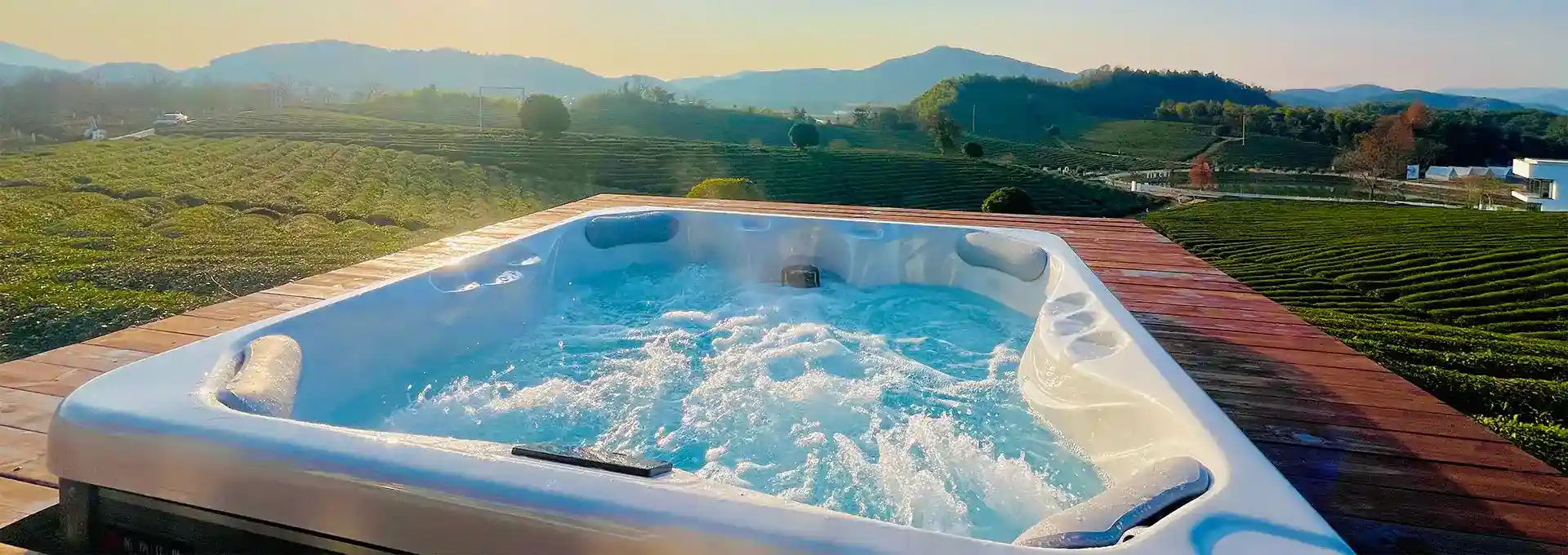How to Clean My Swim Spa?
2024-09-23 15:48:13
Maintaining a clean swim spa is essential for ensuring a safe and enjoyable swimming experience. Whether you're a new swim spa owner or looking to improve your cleaning routine, this guide will walk you through the process of keeping your swim spa in top condition. From understanding the best chemicals to use to knowing how often to change the water, we'll cover everything you need to know about cleaning your swim spa effectively.
What are the best chemicals for an inground swim spa?
Choosing the right chemicals for your inground swim spa is crucial for maintaining water quality and protecting the spa's components. Unlike traditional swimming pools, swim spas have a smaller water volume and higher water temperature, which can affect chemical balance more rapidly. Here are some of the best chemicals to use in your inground swim spa:
1. Chlorine or Bromine: These are the primary sanitizers used in swim spas. Chlorine is more common and cost-effective, while bromine is gentler on the skin and eyes. Both are effective at killing bacteria and other contaminants.
2. pH Balancers: Maintaining the proper pH level (ideally between 7.2 and 7.8) is crucial for water comfort and chemical effectiveness. Use pH increasers or decreasers as needed to keep the water balanced.
3. Alkalinity Increasers: Total alkalinity helps stabilize pH levels. An alkalinity increaser can help maintain the proper range (typically 80-120 ppm for swim spas).
4. Calcium Hardness Increasers: Proper calcium levels (usually 150-250 ppm) prevent corrosion and scaling. Use a calcium hardness increaser if levels are too low.
5. Shock Treatment: Regular shock treatments help oxidize contaminants and restore sanitizer effectiveness. Use either chlorine-based or non-chlorine shock, depending on your preference and spa needs.
6. Enzymes: These natural cleaners break down organic contaminants like oils and lotions, reducing the burden on your sanitizer.
7. Clarifiers: If your water becomes cloudy, a clarifier can help coagulate small particles for easier filtration.
8. Stain and Scale Preventers: These chemicals help prevent mineral buildup on spa surfaces and equipment.
When selecting chemicals, always choose products specifically designed for swim spas or hot tubs. These are formulated to work effectively in the unique environment of a swim spa, with its higher water temperature and jet action.
It's important to follow the manufacturer's instructions carefully when adding chemicals to your swim spa. Overdosing can lead to water imbalances and potential health risks, while underdosing may result in ineffective sanitization. Regular testing of your water chemistry is essential to determine which chemicals are needed and in what quantities.
Remember that the best chemical regimen for your swim spa may vary depending on factors such as usage frequency, number of bathers, and environmental conditions. Don't hesitate to consult with a professional or your swim spa dealer if you're unsure about the best chemical approach for your specific situation.
How often should you change the water in an inground swim spa?
The frequency of water changes in an inground swim spa depends on several factors, including usage, maintenance practices, and water quality. However, as a general rule, most swim spa manufacturers recommend changing the water every 3 to 4 months. Here's a more detailed look at why and how to approach water changes:
Factors Affecting Water Change Frequency:
1. Usage: The more frequently your swim spa is used, and the higher the number of bathers, the more often you may need to change the water.
2. Maintenance Routine: Proper and regular maintenance, including consistent chemical balancing and filtration, can extend the time between water changes.
3. Water Quality: If you notice persistent water quality issues, such as cloudy water or difficulty maintaining proper chemical levels, you may need to change the water more frequently.
4. Environmental Factors: Outdoor swim spas exposed to elements like leaves, pollen, and debris may require more frequent water changes.
Signs It's Time for a Water Change:
1. Foamy or Cloudy Water: If your water remains cloudy or foamy despite proper chemical treatment, it may be time for a change.
2. Difficulty Maintaining Chemical Balance: When you find it increasingly challenging to keep your chemical levels stable, fresh water may be needed.
3. Unpleasant Odors: A strong chlorine smell or other unusual odors can indicate that it's time for a water change.
4. Visible Buildup: If you notice scale or other deposits forming on spa surfaces, changing the water can help.
5. Total Dissolved Solids (TDS) Levels: High TDS levels (typically over 1500 ppm) suggest it's time for fresh water.
Steps for Changing Your Inground Swim Spa Water:
1. Plan Ahead: Choose a time when you won't need to use the spa for a day or two.
2. Turn Off and Unplug: Ensure all electrical components are safely disconnected.
3. Drain the Spa: Use a submersible pump or the spa's drain valve to remove the water. Be mindful of local regulations regarding water disposal.
4. Clean the Shell: With the water drained, take this opportunity to clean the spa's interior surfaces thoroughly.
5. Clean or Replace Filters: Deep clean your filters or replace them if necessary.
6. Refill the Spa: Use a hose filter to prevent impurities from entering as you refill.
7. Balance the Water: Add the necessary chemicals to balance the fresh water.
8. Heat and Circulate: Allow the water to heat up and circulate before use.
Extending Time Between Water Changes:
While regular water changes are necessary, you can take steps to maximize the time between changes:
1. Maintain Proper Chemical Balance: Regular testing and adjustment of chemical levels can significantly extend water life.
2. Use a Quality Filtration System: Ensure your filters are clean and functioning properly.
3. Shower Before Use: Encourage all users to shower before entering the spa to reduce contaminants.
4. Use Spa Enzymes: These can help break down organic contaminants, reducing the load on your sanitizer.
5. Cover When Not in Use: A good cover prevents debris from entering the water and reduces chemical loss due to evaporation.
By following these guidelines and paying attention to your swim spa's specific needs, you can ensure that your water remains clean, safe, and enjoyable between changes. Remember, while extending the time between water changes can be convenient, it should never come at the cost of water quality and user safety.
Can you use regular pool chemicals in an inground swim spa?
While it might seem convenient to use regular pool chemicals in your inground swim spa, it's generally not recommended. Swim spas and pools have different characteristics that affect their chemical needs. Here's a detailed explanation of why pool chemicals aren't ideal for swim spas and what you should use instead:
Differences Between Pools and Swim Spas:
1. Water Volume: Swim spas have a much smaller water volume compared to pools, which means chemicals can have a more concentrated effect.
2. Water Temperature: Swim spas typically operate at higher temperatures (around 80-104°F or 27-40°C), which affects chemical reactions and stability.
3. Jet Action: The powerful jets in swim spas create more aeration and turbulence, which can impact chemical effectiveness and dissipation rates.
4. Usage Patterns: Swim spas often see more frequent use relative to their size, leading to a higher concentration of contaminants per gallon of water.
Why Pool Chemicals Aren't Ideal for Swim Spas:
1. Concentration: Pool chemicals are often more concentrated and designed for larger volumes of water. Using them in a swim spa can lead to over-treatment and potential health risks.
2. pH Impact: Pool chemicals may have different effects on pH levels in the smaller, warmer environment of a swim spa.
3. Stabilizers: Many pool chlorine products contain stabilizers (cyanuric acid) which can build up quickly in a swim spa, potentially leading to "chlorine lock."
4. Foaming: Some pool chemicals may cause excessive foaming in the high-agitation environment of a swim spa.
5. Equipment Damage: Using the wrong chemicals can potentially damage your inground swim spa's pump, heater, and other components.
What to Use Instead:
1. Spa-Specific Sanitizers: Use chlorine or bromine products specifically formulated for spas and hot tubs. These are designed to work effectively in smaller, warmer water environments.
2. Balanced pH and Alkalinity Products: Choose pH and alkalinity adjusters made for spas, which are formulated to work in smaller water volumes.
3. Spa Shock: Use a non-chlorine shock or a chlorine shock designed for spas to oxidize contaminants without overwhelming the system.
4. Specialty Spa Chemicals: Products like enzymes, clarifiers, and scale preventers designed for spas can help maintain water quality more effectively than their pool counterparts.
5. Test Strips or Kits: Use testing products calibrated for spa water ranges to accurately measure chemical levels.
Tips for Using Spa Chemicals Safely:
1. Read Labels Carefully: Always follow the manufacturer's instructions for dosing and usage.
2. Start Small: When adding chemicals, start with smaller amounts than recommended and retest before adding more.
3. One at a Time: Add chemicals one at a time, allowing circulation between additions to prevent unwanted reactions.
4. Regular Testing: Test your water frequently to maintain proper chemical balance.
5. Professional Advice: Consult with a spa professional or your dealer for guidance on the best chemical regimen for your specific swim spa model.
Exceptions and Considerations:
While it's generally best to stick with spa-specific chemicals, there are a few exceptions:
1. Some basic chemicals like pH increasers or decreasers may be similar for pools and spas, but always check the label for spa-safe confirmation.
2. In emergencies, pool shock can be used in a swim spa, but it should be heavily diluted and used with extreme caution. This should not be a regular practice.
3. If you're considering using any pool product in your swim spa, always consult the manufacturer or a professional first to avoid potential damage or safety issues.
By using the right chemicals designed specifically for swim spas, you can ensure better water quality, safer swimming conditions, and longer-lasting equipment. While it might seem more convenient or cost-effective to use pool chemicals, the potential risks and inefficiencies make it a practice best avoided. Invest in proper spa chemicals to protect your investment and enjoy a cleaner, safer swimming experience.
In conclusion, maintaining a clean swim spa requires understanding the unique needs of these compact aquatic environments. By using the right chemicals, changing the water at appropriate intervals, and avoiding the temptation to use regular pool chemicals, you can ensure that your inground swim spa remains a safe, enjoyable, and hygienic space for exercise and relaxation. Remember, proper maintenance not only enhances your swimming experience but also protects your investment by prolonging the life of your swim spa and its components. Always consult your swim spa's manual and don't hesitate to seek professional advice for the best care practices tailored to your specific model and usage patterns.
For more information on hot tub installations and our products, please feel free to contact us at info@iparnassus.com.
References:
1. Lowry, S. (2022). The Complete Guide to Hot Tub and Swim Spa Maintenance. Aqua Magazine.
2. Johnson, R. (2023). Swim Spa Chemistry 101: Balancing Act for Perfect Water. Pool & Spa Review.
3. Smith, A. (2021). Understanding the Differences: Pool vs. Spa Chemical Treatment. Journal of Aquatic Health.
4. Thompson, L. (2023). Best Practices for Inground Swim Spa Maintenance. Poolside Magazine.
5. Garcia, M. (2022). The Impact of Water Chemistry on Swim Spa Longevity. International Spa Association Journal.
6. Brown, K. (2023). Eco-Friendly Approaches to Swim Spa Care. Green Living Today.
7. Wilson, J. (2021). Swim Spa Water Changes: Timing and Techniques. Spa & Pool Industry Report.
8. Taylor, E. (2022). Chemical Safety in Home Aquatic Environments. National Swimming Pool Foundation.
9. Roberts, P. (2023). Optimizing Filtration Systems for Swim Spas. Aquatic Technology Review.
10. Anderson, H. (2021). The Science of Spa Water: Understanding Chemical Interactions. Water Quality & Health Council.



